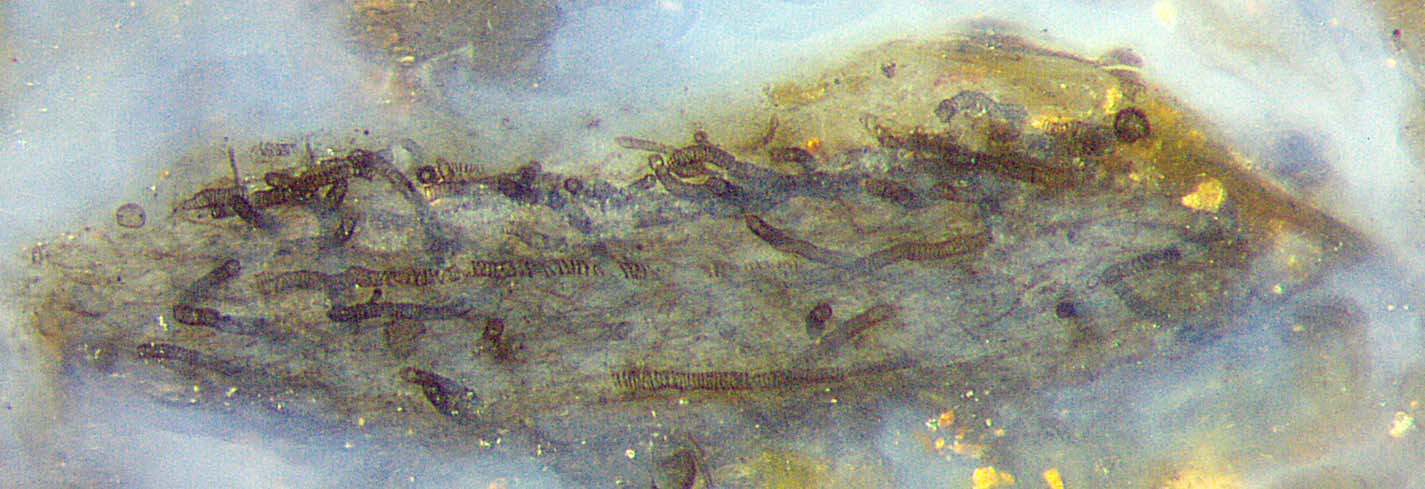Another tangle of tubes in chert
(revised version)
Fossil tubes, a
few Ám up to near 100Ám wide, with or without wall pattern, separate
(Fig.1) or in tangles (Fig.2), are most often nematophytes. Their
affiliation is disputed, hence they are listed in [1] under "Enigmatic
Organisms". They are not often seen in the
famous Rhynie chert. Judging from the
few
samples hitherto found, the tangles of tubes can
be more
or less aligned, or even strictly
aligned as with Pachytheca. Some
of them seem to consist of smooth-walled tubes only, as those
presented in Rhynie
Chert News 13,
30, 40,
46,
92,
98,
99.
Distinctly different is
Nematoplexus
with its evenly wound smooth tubes and occasional irregularly curved
patterned ones among them [2]. A short fragment of such tube close to a
"branch knot" of Nematoplexus in
this sample is seen in Rhynie
Chert News 151.
A long tube of the same type is nearby: here Fig.1. It
may be
problematic to relate the forms to species. The
separate tube in Fig.1 might belong to Nematoplexus,

Fig.1: Nematophyte tube fragment, diameter 26Ám, with
spirals or annular rings on the wall, spacing
mostly 5-6Ám.
(Part of the tube is hidden in the depth.) Width of
the image 0.8mm.
This sample suggests an unexpected alternative
interpretation: Before silicification,
the big tubes with patterned wall in Fig.2 had
probably been placed within a lump of organic gel, together with tiny
filaments. As noticed by P.
Strother
[3], the fossil in Fig.2 strongly resembles Nematothallus pseudo-vasculosa
known as compression fossils [4]. The size data are roughly compatible,
including
the dimly seen tiny filaments which seem to correspond with
"tubes
between 1.5 and 3Ám in diameter" seen on the lectotype of that
organism
[4,5].
Similar as with the tube fragments scattered sparsely
throughout the chert, the tubes in the gel lump do not show branching
nor other remarkable features, perhaps except for one peculiarity
poorly seen above left: A big tube reduces its diameter to
less than half, then ends.
What looks like a series of orderly turns of a screw in
Fig.1 is often interrupted by disorder due to merging or branching
turns, as also seen repeatedly in
Fig.2.
Fig.2 (below): Uncommon assemblage of nematophyte tubes as a separate patch, probably of silicified organic gel,
with tube diameters centered around an average of
20Ám, and a wide variety of spacings between turns
of the tube wall pattern. Width of the image 1.9mm, same scale as above.

Drawing conclusions from
only one sample may not be justified here but asking questions may
be appropriate:
- Is there a phylogenetic connection between the wide tubes
with
annular /spiral wall pattern which are a main constituent of Nematothallus
and the similar tubes which
are only occasionally seen among the smooth-walled tubes of Nematoplexus ?
- Is the placement of this 3D-version
of
Nematothallus
near Nematoplexus
in the chert incidental?
Finally it may be mentioned that this sample of mere 0.28kg
has offered several remarkable items:
Nematoplexus
with tubes larger and smaller than hitherto known (2009, 2017), Nematoplexus with weakly curved tubes (2013), Castracollis
eye (? 2015) and unidentified moults, an unknown archetypal charophyte
(2016), and possibly the first 3D-version of Nematothallus as seen above (2017). Seems extremely wondrous !
Sample:
Rh9/86 (2003,
0.28kg).
Annotation
2018:
The tube wall patterns, more clearly seen in Rhynie
Chert News 122,
resemble the tracheid wall patterns of land plants. This has led to the
following conclusion: "The study of the
nematophytes will become more central to
the issue of the rise of the earliest land plants because they
clearly have developed a diverse and somewhat complex tubular
anatomy, which in many ways appears to be analogous to vascular
tissue [4]".
H.-J.
Weiss 2017
(modified: June 2017) 2018
2020
[1] T.N.
Taylor,
E.L.Taylor, M. Krings: Paleobotany, Elsevier
2009.
[2]
A.G. Lyon:
On the fragmentary remains of an organism referable to the
nematophytales,
from the Rhynie chert, Nematoplexus
rhyniensis.
Trans. Roy. Soc. Edinburgh
65(1961-62), 79-87, 2 plates.
(Scale error on Plate I Fig.1: not x19 but x1.5)
[3] P.K.
Strother:
private communication (2017).
[4] P.K.
Strother:
Clarification of the genus Nematothallus
Lang:
J. Paleont. 67(1993), 1090-1094.
[5] W.H. Lang:
On the plant-remains from the Downtonian ... .
Phil. Trans. Roy. Soc. London B 227(1937),
245-291.
 |
 |
107 |





